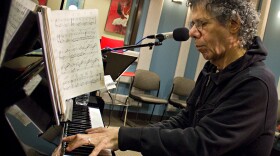This feature is derived from KNKX's Tree of Jazz, taking you through the eras, from the roots to the new budding leaves, with a weekly deep dive into iconic artists, albums, and instruments.
The Hammond B-3 organ has been a great friend to jazz for many decades. Its sweet, funky, and warm tones have an unmatched way of lifting the spirits. It's a friendship that began in the ‘50s with organist Jimmy Smith, who refined the enduring jazz trio of organ, guitar, and drums with incredible technique, groove, blues—and unmatched showmanship.
Like Smith, Jack McDuff, and Jimmy McGriff were other early artists known for their mastery of the format. Then, in the 1960s, Larry Young from Newark, New Jersey, who had refined his skills on the instrument with extra hints of the blues, was signed to Blue Note Records as the label looked to expand its roster.
With Blue Note, Young developed a sonically audacious, fiery, and explorative voice, reinventing how jazz organ could sound. Young was inspired by the emerging "modal” approaches of Miles Davis and John Coltrane, and became known as “the John Coltrane of the organ,” a phrase first used by organ great McDuff. His record Unity, recorded 60 years ago today, marked one of the artist's first bold statements in the modal direction.
On Unity, Young was joined by trumpeter Woody Shaw, a fellow Newarker known for expanding the trumpet’s vocabulary. The record also includes saxophonist Joe Henderson, who was carving his own way forward as a composer of beautiful, gritty, and sometimes, challenging sounds. Thunderous drummer Elvin Jones, fresh off a stint with the Coltrane Quartet, also brought his power and propulsion into Young’s orbit.
The album’s opener, “Zoltan,” is everything you want from someone who lived in the house that Coltrane built. Shaw and Henderson’s horns bounce and zigzag on the chorus, inspired partly by Hungarian composer Zoltán Kodály’s “Háry János Suite.” On the track, Shaw climbs mighty peaks, with urgency; Henderson begins with a low roar and ends in furious melodic screams. The pressing pulse from Jones, alongside Young, drives the song through many shades of intensity and wonder. Then the tension settles, and Young roars in, taking the B-3 organ down unlit paths.
Then there’s Jones and Young duet on “Monk’s Dream,” Thelonious Monk’s playful composition. Young holds the groove with the organ’s bass pedals while going on explosive runs, met by Jones’ daring drums. Afterwards, the quartet ascends and leaps on “The Moontrane,” written by Shaw with Coltrane in mind. Young provides bouncing chords while Jones’ jittery snare hits and signature swing lay the backdrop for Shaw and Henderson to explore.
Though Young never recorded with Coltrane, he did jam with him. Reportedly, Young said he and Coltrane would have “space conversations,” jamming for hours at Coltrane’s Long Island home. As his wife, Althea Young, said in the Newark Star Ledger, “They’d go into the studio for hours on end, and they wouldn’t speak fifty sentences to each other while they were in there.”
After Unity, Young continued exploring. A few years later on Contrasts, there’s a remarkable version of the ballad, “Wild Is the Wind,” sung by Althea and underscored by an extraterrestrial swirl from Young’s organ.
Eventually, Young’s sessions grew gradually more avant-garde, and he began to incorporate funk and rock influences. After Coltrane’s death, he recorded “A Love Supreme” with Carlos Santana and John McLaughlin. He was a member of Tony Williams Lifetime jazz fusion group, appeared on Miles Davis’ Bitches Brew, and took part in the Record Plant sessions with Jimi Hendrix. On “It’s Too Bad,” Young provides the underlying canvas as Hendrix roars through the blues, and another recording, “Young/Hendrix,” captures a raw, abrasive jam.
Young created through much of the ’70s and died unexpectedly in 1978 at age 37. In his short life, he unleashed new sounds from the organ, exploring the full gamut of tone and texture. Unity is an essential part of his lasting legacy, which still echoes on 60 years later.
This story comes from the Nov. 09, 2025, episode of the Tree of Jazz. Listen to the past two weeks of Tree of Jazz On-Demand, and hear deep dives like this each week on air and online every Sunday from 3-6 p.m. PT.








